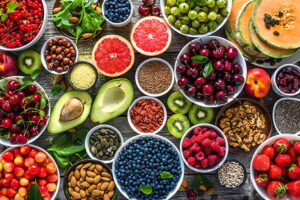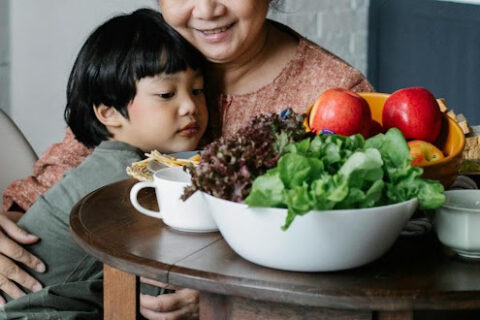The Transformative Role of Play in Children’s Learning: Exploring Food Adventures

Hey, Kepler Families! I’m Megan Wallace, RD and I’m thrilled to share my first-ever blog post with you. I am extremely passionate about food and fostering a positive relationship with food from the start. One thing I found hard when I became a parent was how to actually PLAY with my food… I grew up with the mindset that you just don’t do that. The more I have learned in practice the more I understand how important food play is and the remarkable impact of play on children’s learning and development. Play is not merely a pastime; it’s a fundamental aspect of childhood that shapes cognitive, social, and emotional skills. Let’s delve into the captivating world of play and how it can be a catalyst for children to discover the wonders of new foods, paving the way for a lifetime of healthy eating habits.
Play is the language of childhood, the medium through which children make sense of the world around them. Whether it’s imaginative play, sensory exploration, or physical activity, play provides children with the opportunity to experiment, problem-solve, and express themselves freely. But what role does play have in shaping children’s attitudes towards food?
Food plays a central role in our lives, not only nourishing our bodies but also shaping our cultural identities and social interactions. Introducing children to a diverse range of foods at a young age lays the foundation for healthy eating habits later in life. However, we know that getting children to try new foods can be a daunting task for many parents. This is where the power of play comes into play.
When children engage in food-related play activities, they embark on a sensory journey that goes beyond mere taste and texture. Through play, they explore the colors, shapes, smells, and even sounds of different foods, expanding their palate and cultivating a sense of curiosity and adventure. Here are ten food play ideas to spark your child’s culinary imagination:
- Kitchen Creations: Transform your kitchen into a culinary playground where children can unleash their creativity. Provide child-safe utensils, bowls, and ingredients, and let them experiment with mixing, pouring, and measuring. Whether they’re concocting pretend soups or baking imaginary cakes, kitchen play encourages children to explore the textures and properties of various ingredients.
- Farmers Market Pretend Play: Set up a farmers market role-play area complete with baskets of play fruits and vegetables, cash registers, and shopping bags. Encourage children to take on the roles of farmers, vendors, and customers as they engage in pretend shopping and cooking activities. This immersive experience introduces children to the concept of where food comes from and encourages them to interact with a variety of produce.
- Sensory Bins: Create sensory bins filled with food items such as uncooked rice, pasta, beans, or even cereal. Add scoops, funnels, and containers for scooping and pouring. Children will delight in exploring the different textures, shapes, and weights of the food items while honing their fine motor skills and sensory awareness.
- Food Art: Encourage children to express their creativity through food art. Provide a variety of fruits, vegetables, cheese slices, and other edible materials, along with child-safe knives and cookie cutters. Children can create masterpieces on plates or cutting boards, exploring colors, patterns, and shapes while developing their fine motor skills.
- Storybook Cooking: Choose children’s books that feature food-related stories and characters. After reading the story together, invite children to recreate the dishes mentioned in the book. This activity not only promotes literacy but also introduces children to new foods in a familiar context, sparking their interest and curiosity.
- Picnic Pretend Play: Set up a pretend picnic indoors or outdoors, complete with blankets, picnic baskets, and play food. Encourage children to pack their own picnic baskets with a variety of snacks and sandwiches, fostering independence and decision-making skills. As they role-play eating and sharing food with friends or stuffed animals, they develop social skills and learn about mealtime etiquette.
- Garden Exploration: If you have a garden or access to a community garden, take children on a nature walk to explore the different fruits, vegetables, and herbs growing. Encourage them to touch, smell, and even taste the fresh produce, fostering a connection to nature and an appreciation for where food comes from.
- Smoothie Bar: Set up a DIY smoothie bar with a selection of fruits, yogurt, milk, and juice. Provide blenders, cups, and straws, and let children create their own smoothie concoctions. This hands-on activity not only introduces children to a variety of fruits but also teaches them about healthy beverage choices.
- Food Tasting Parties: Host food tasting parties where children can sample a variety of foods from different cultures or cuisines. Create tasting stations with small portions of foods such as fruits, vegetables, cheeses, and crackers. Encourage children to use their senses to describe the taste, texture, and aroma of each food item, fostering sensory awareness and language development.
- DIY Pizza Night: Turn pizza-making into a fun family activity by setting up a DIY pizza station with pre-made pizza dough and an assortment of toppings. Let children customize their pizzas with their favorite ingredients, teaching them about balanced meal choices and encouraging them to try new flavors.
In an effort to be resourceful and mindful of the rising cost of food prices, food play shouldn’t feel like a ‘waste of money’, somethings you can do to be as resourceful as possible when it comes to food play and food cost include:
- Making use of foods that have been played with in smoothies, soups or pureed into pasta sauces
- Offering a small portion of a food to play with – it doesn’t have to be huge for your child to learn about the sensory characteristics of that food
- Encourage food play during ‘prep’ – child-safe knives can be a great way to get your little to help in the kitchen, engage in food play and prep a family supper!
Play is likely the most powerful tool for children’s learning and development, including their relationship with food. By incorporating food play into their daily routines, parents and caregivers can ignite children’s curiosity, creativity, and adventurous spirit when it comes to trying new foods. Remember to make food play a positive and enjoyable experience, free from pressure or coercion. Together, let’s empower our children to embrace a lifetime of healthy eating habits through the magic of play.

